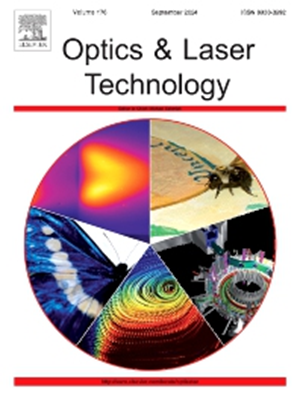Mirror-symmetric multi-OAM vortex beam generation with 1-bit interleaved terahertz metasurfaces
IF 5
2区 物理与天体物理
Q1 OPTICS
引用次数: 0
Abstract
Recently, vortex beams carrying various orbital angular momentum (OAM) have become a research boom in terahertz wireless communications due to their infinite modes. However, existing metasurfaces difficultly generate multi-OAM vortex beams with different topological charges simultaneously, which severely limits their practical applications due to low channel capacity and number. To address the above issues, here, a 1-bit interleaved terahertz metasurface is proposed to implement the polarization multiplexing and generate mirror-symmetric multi-OAM vortex beams with opposite topological charges. The supercell of interleaved terahertz metasurface consisting of two pairs of cross-metal subunit. The irrotational cross-metal subunit can implement line polarization (LP) multiplexing by using the independent propagation phase, while the rotational cross-metal subunit can realize circular polarization (CP) multiplexing by combining the geometric phase and the propagation phase, thereby enhancing the channel number. By 1-bit quantization phase strategy, furthermore, each channel can generated mirror-symmetric vortex beam with opposite topological charge simultaneously, increasing the channel capacity. As a conceptual demonstration, a 1-bit interleaved terahertz metasurfaces is constructed by the above interleaved supercell. By adjusting the polarization states of the incident waves, three or four pairs of mirror-symmetrical vortex beams with opposite topological charges can be generated simultaneously. Moreover, the generated vortex beams have a good agreement with the theoretical design. Therefore, the proposed scheme shows the significant advantages of large channel number, high channel capacity, and simple construction of metasurfaces, which offers the promising applications in terahertz multifunctional integrated-devices and high-speed and large-capacity 6G communications.
具有1位交错太赫兹超表面的镜像对称多oam涡旋光束生成
近年来,携带不同轨道角动量的涡旋波束因其模式无限而成为太赫兹无线通信领域的研究热点。然而,现有的超表面难以同时产生具有不同拓扑电荷的多oam涡旋光束,通道容量小,通道数量少,严重限制了其实际应用。为了解决上述问题,本文提出了一个1位交错太赫兹超表面来实现极化复用,并产生具有相反拓扑电荷的镜像对称多oam涡旋光束。由两对交叉金属亚基组成的交错太赫兹超表面超级单体。非旋转交叉金属亚基可以利用独立传播相位实现线极化(LP)复用,旋转交叉金属亚基可以利用几何相位和传播相位相结合实现圆极化(CP)复用,从而增强信道数。此外,通过1位量化相位策略,每个通道可以同时产生具有相反拓扑电荷的镜像对称涡旋光束,增加了通道容量。作为一个概念演示,一个1位的交错太赫兹超表面是由上述交错超级单体构成的。通过调节入射波的偏振态,可以同时产生三对或四对拓扑电荷相反的镜像对称涡旋光束。产生的涡旋光束与理论设计吻合较好。因此,该方案具有通道数大、通道容量大、元表面结构简单等显著优势,在太赫兹多功能集成器件和高速大容量6G通信中具有广阔的应用前景。
本文章由计算机程序翻译,如有差异,请以英文原文为准。
求助全文
约1分钟内获得全文
求助全文
来源期刊
CiteScore
8.50
自引率
10.00%
发文量
1060
审稿时长
3.4 months
期刊介绍:
Optics & Laser Technology aims to provide a vehicle for the publication of a broad range of high quality research and review papers in those fields of scientific and engineering research appertaining to the development and application of the technology of optics and lasers. Papers describing original work in these areas are submitted to rigorous refereeing prior to acceptance for publication.
The scope of Optics & Laser Technology encompasses, but is not restricted to, the following areas:
•development in all types of lasers
•developments in optoelectronic devices and photonics
•developments in new photonics and optical concepts
•developments in conventional optics, optical instruments and components
•techniques of optical metrology, including interferometry and optical fibre sensors
•LIDAR and other non-contact optical measurement techniques, including optical methods in heat and fluid flow
•applications of lasers to materials processing, optical NDT display (including holography) and optical communication
•research and development in the field of laser safety including studies of hazards resulting from the applications of lasers (laser safety, hazards of laser fume)
•developments in optical computing and optical information processing
•developments in new optical materials
•developments in new optical characterization methods and techniques
•developments in quantum optics
•developments in light assisted micro and nanofabrication methods and techniques
•developments in nanophotonics and biophotonics
•developments in imaging processing and systems

 求助内容:
求助内容: 应助结果提醒方式:
应助结果提醒方式:


